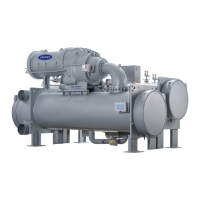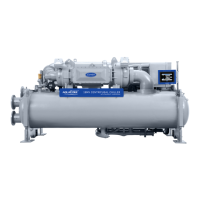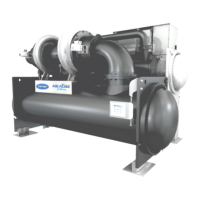44
Fig. 41 — Moisture Indicator Sight Glass for inspection
Inspect the Purge — With unit off drain, purge tank
by entering QUICK TEST menu, opening Drainage Sole-
noid Valve, and Purge Condenser Solenoid Valve, and turn-
ing the Refrigerant pump on to drain the refrigerant liquid.
Let it run for about 15 minutes. Turn on Purge Compressor
and verify that it runs. Close all valves using the Quick Test
Menu. Clean the condenser coil as required and replace the
strainer as needed.
Changing Refrigerant Lubrication Filters —
Change the refrigerant lubrication filter, motor cooling fil-
ter, and bearing filter on an annual basis or when the chiller
is opened for repairs. The filters can be isolated so they can
be changed with refrigerant remaining in the chiller. Strain-
ers such as 2x refrigerant pump suction strainers, inhibitor
reclaim, and inductor are to be replaced every 5 years or as
required when the machine is open for service. These filters
do not contain desiccant for moisture removal so changing
the filter will not change the moisture indicator status.
Change strainers/filters by closing isolation valves and
slowly opening the flare fitting with a wrench and back-up
wrench to relieve pressure.
Inspect Refrigerant Float System — Perform this
inspection only if the following symptoms are seen.
• There is a simultaneous drop in cooler pressure and
increase in condenser pressure. This will be accompa-
nied by an increase in kW/Ton.
• The liquid line downstream of the float valve feels warm
and float valve seems stuck based on a visual inspection
through the end cover sight glass. This indicates con-
denser gas flowing past the float.
1. Transfer the refrigerant into a pumpout storage tank.
2. Remove the float access cover.
3. Clean the chamber and valve assembly thoroughly. Be
sure the valve moves freely. Ensure that all openings are
free of obstructions.
4. Examine the cover gasket and replace if necessary.
This applies for both the high side float (first float
downstream of condenser) and the low side float (second
float downstream of condenser). The float refrigerant level
can be observed through the two sight glasses located on
the float cover under the condenser. See Fig. 42 for float
detail. Inspect the float every five years. Clean the cham-
ber and the float valve assembly. Be sure that the float
moves freely and the ball bearings that the float moves on
are clean.
Fig. 42 — Float System
Inspect Safety Relief Devices and Piping — The
relief device on this chiller protects the system against the po-
tentially dangerous effects of overpressure. To ensure against
damage to the equipment and possible injury to personnel,
these devices must be kept in peak operating condition.
As a minimum, the following maintenance is required.
1. At least once a year, disconnect the vent piping at the
valve outlet and carefully inspect the rupture disk for any
evidence of internal corrosion or rust, dirt, scale, leakage,
etc. Verify that vent piping has a section leaning away
from valve to avoid the valve outlet becoming a trap for
dirt, condensation etc.
2. If corrosion or foreign material is found, do not attempt to
repair or recondition. Replace the safety relief device.
MOISTURE
INDICATOR
SIGHT GLASS
FOR INSPECTION
NOTE: SECOND INDICATOR IS
LOCATED IN THE MOTOR/VFD
COOLING LINE (ON THE
CONDENSER SIDE) COMING
OFF THE BOTTOM OF THE
HIGH SIDE FLOAT CHAMBER.

